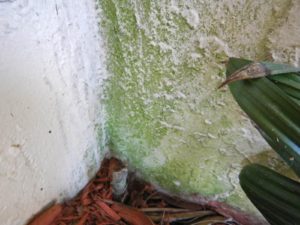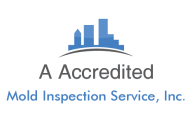Is outdoor mold a problem? Is it a health threat?
In my personal opinion I do not believe outdoor mold is usually a health problem. Of course, there are exceptions to every rule. Let’s look at a few exceptions
One exception would be an increase in the level of outdoor mold spores or pollen levels during thunderstorms or prolonged rain events. The Cleveland Clinic offers more information on this topic.
Another exception would be a similar issue that occurs after severe flooding or hurricanes. For example, after hurricane Katerina caused widespread flooding in New Orleans some people were reported to have upper respiratory complaints triggered by outdoor air. This was attributed to microbial growth on soaking wet building debris.
Real World Examples
I once did a mold inspection for an elderly women who contracted a severe fungal infection of the sinuses, specifically it was called mucor mycosis. She contracted it while working with very moldy mulch in her garden. But this is not normal, she likely has a compromised immune system.
While I was attending a class in mold spore analysis at the McCrone Research Institute in Chicago the instructor who was a mycologist ( mold scientist ) reported that he personally knew of a man that contracted a fungal infection. The infection was from a mold called Aspergillus fumigatus. The man later died as a result of his infection. After an investigation was conducted it was believed he got if from outdoor mold spores blowing from a local landfill.
Please do not overreact. Serious fungal infections typically only occur in the immunocompromised so please do not panic. Furthermore, most healthy people don’t seem to get sick at all from mold growing outside their homes. The primary reason is because outdoor mold is diluted by the entire planets atmosphere.

The above image is of algae growing on the exterior of a client’s wall in Boynton Beach Fl. She was concerned about other issues indoors but I though you might like to see this image.
Is this green stuff growing on my house algae or mold?
If you are seeing what appears to be a very thin non textured green growth on the exterior walls of your house in a moist environment, this is most likely algae. It may look as if someone tried to dye the stones green. It will only grow where it can receive plenty or rain, or sprinkler water and sometimes it may appear wet or slimy in appearance.
Algae are usually an aquatic plant, but it will grow on shady moist walls, sidewalks, tree trunks, even old cars. It is not related to mold and this material is not likely to cause any negative health effects or bad odors. In fact, algae in the sea produce much of the world’s oxygen.
Algae likes a little sunlight. If it is green and growing outdoors it is usually algae utilizing the sun’s rays for photosynthesis.
If it is green and growing indoors it is usually mold. Why do molds like the indoors? Because indoors they get protection from the suns UV rays.
MOSS
If it consists of thick and bushy patches of fern like, or grass like interconnected plants not much taller that the letters on this computer screen, then you have moss. Mosses like algae are not suspected of resulting in allergy or other health problems like mold.
LIVERWORTS
Liverworts look like tiny green liver shaped leaves growing without stems or roots. The liver part of the name refers to the liver shape of the plant, and the term wort is an old English term meaning plant. They grow interconnected on moist surfaces such as stones and dead trees. In addition, they prefer very moist shady wooded areas and stream banks. Thus, if you see plants fitting the above description, and growing in the above referenced type of habitat, it is likely a patch of Liverworts.
LICHENS
If you have rough textured patches of gray, green, or grayish green mold like material that look like wrinkled, leathery, potato chips then you have an interesting colony of algae and mold growing together. This plant is called lichen. In Lichens the mold fibers provide nutrients and a moist shady substrate for the algae to grow in. The algae gives the colony it’s greenish appearance and provides carbohydrates to the mold. They live together happily and grow everywhere around the world from swamps to deserts.
I have seen lots of lichens growing on rocks in dry desert hillsides in Hurricane Utah, former home of the Certified Mold Inspectors and Contractors Institute. I have also seen them routinely while hiking on boardwalks in hot, humid, rainy, South Florida wetlands. In south Florida wetlands it loves to grow on the trunks of cypress trees. Growing up in Ohio I used to see it on tree trunks in deciduous forests.
Baton Rouge Louisiana gets its name from red patches of lichens that grow in swamps in the area, and reindeer moss in the tundra is also a type of lichen. Reindeer moss like lichens are also very common in Jonathan Dickinson State park in Jupiter Florida. I do not know of any air quality problems associated with lichens, in fact some are edible.
Is this black material on my exterior walls mold?
SOOTY MOLD
If you have black mold growths outdoors it is very likely what is commonly called sooty mold. Sooty mold is a loose non scientific term used to describe several outdoor molds that look like black soot. For more information on Sooty molds click here.
Sooty mold usually consists of a type of mold more accurately described as Cladosporium mold. The phenomenon is very common and is more of a cosmetic problem than anything. For more information on Cladosporium mold click here.
About A Accredited Mold Inspection Service, Inc.
Our mold inspector and indoor air quality testing consultant specializes in providing professional quality services. We cater to home owners, and commercial building managers with suspected humidity issues, mold, and other building related IAQ issues. We provide services for all towns in, near, and around all of South East Florida. To see what areas we cover click here.




